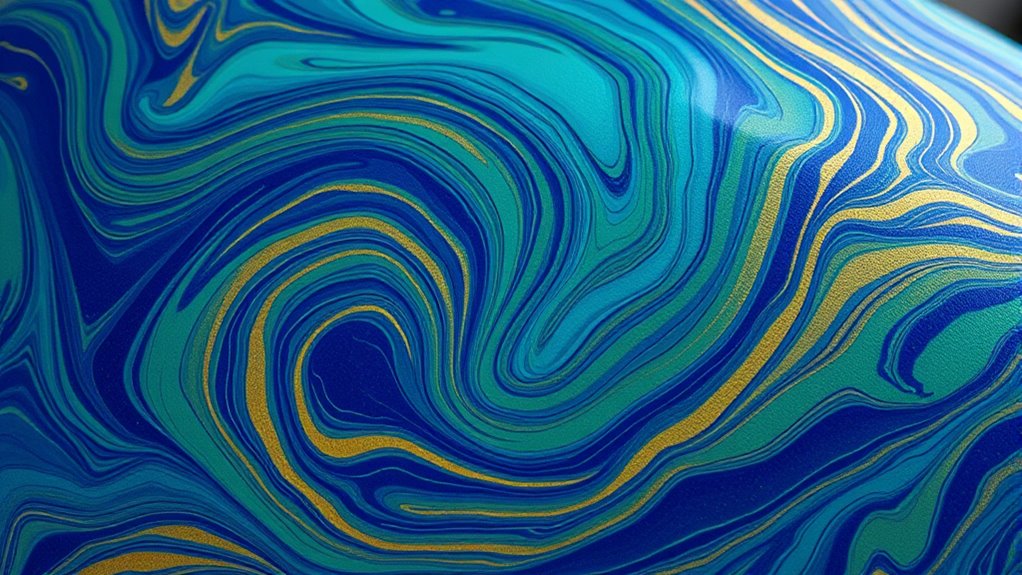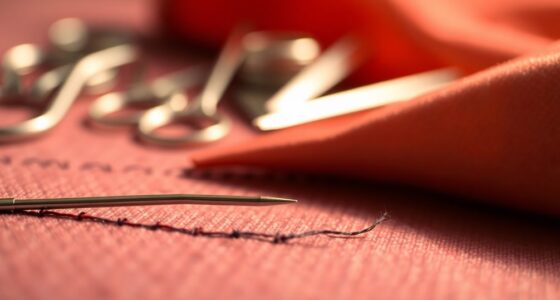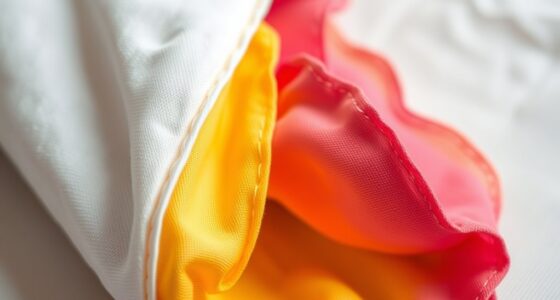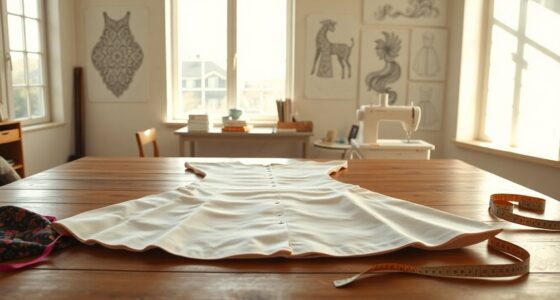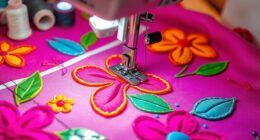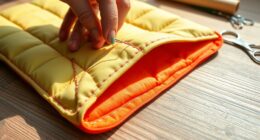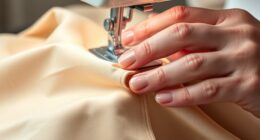You can create beautiful swirl effects on fabric using simple household items—no special gear needed. Mix water-based dyes or fabric paints with thickening agents like cornstarch or carrageenan to make a smooth, paint-like mixture. Drop different colors onto the surface, then swirl or manipulate them with toothpicks or brushes. Carefully submerge your fabric to transfer the patterns, then rinse and dry. Want to explore more tips for mastering marbling? Keep going to discover how to enhance your designs further.
Key Takeaways
- Use household water-based dyes or fabric paints mixed with thickening agents like cornstarch or carrageenan for a paint-like consistency.
- Fill a shallow tray with the viscous dye mixture, then gently add different colors on the surface to create swirling patterns.
- Manipulate the floating dyes with tools such as toothpicks, brushes, or skewers to swirl or drag colors without needing special equipment.
- Dip your damp, clean fabric carefully into the marbled surface to transfer the swirl patterns onto the textile.
- Rinse the fabric after dipping, then lay flat to dry, revealing unique, spontaneous marbled swirl effects without specialized gear.
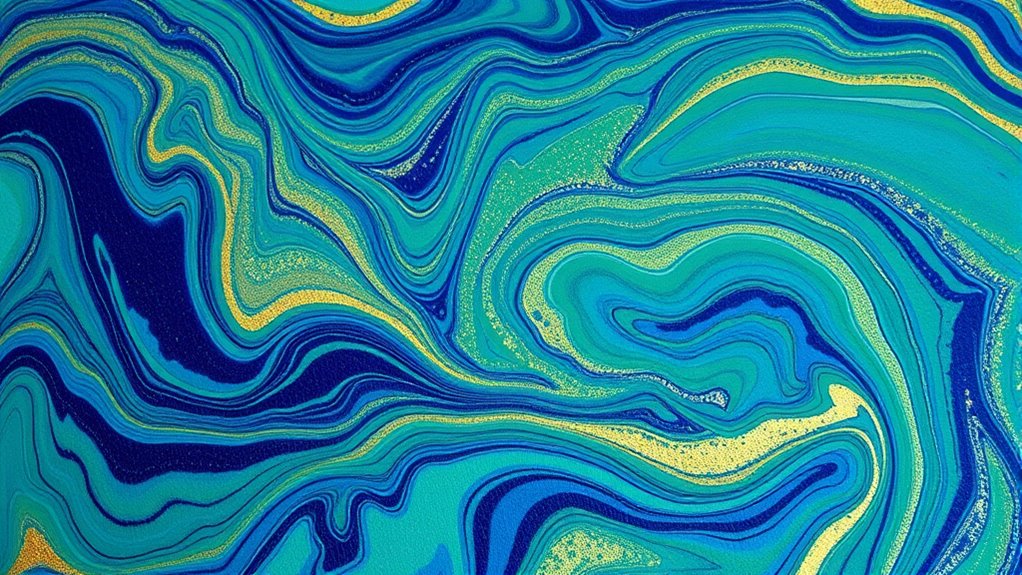
Marbling on fabric is a mesmerizing art form that transforms plain textiles into vibrant, swirling masterpieces. This technique allows you to create stunning, one-of-a-kind designs without needing expensive equipment or complex tools. If you’re interested in fabric dyeing and exploring textile art techniques, marbling offers a fantastic way to add color and movement to your projects. It’s accessible, creative, and highly satisfying once you see the beautiful patterns emerge on your fabric.
Marbling transforms plain fabric into vibrant, swirling masterpieces with simple, accessible techniques.
To start marbling on fabric, you don’t need specialized marbling kits. Instead, you can use simple household items and basic materials. Prepare a shallow tray or basin filled with a viscous, colorful dye mixture. Traditional fabric dyeing techniques involve mixing water-based dyes or fabric paints with a thickening agent like carrageenan or cornstarch. This creates a smooth, paint-like consistency that allows the colors to float and swirl effortlessly on the surface of the liquid. When you gently add drops of different colors to the surface, they spread out and interact, forming intricate, organic patterns. You can manipulate these patterns by using tools like toothpicks or brushes to swirl or drag the colors, creating mesmerizing marbled effects.
The key to successful marbling on fabric lies in understanding how the dye interacts with the surface and how to control the movement of the colors. As you dip your fabric into the floating dye, make sure it’s properly prepared—clean, damp, and free of any coatings that might interfere with dye adhesion. Submerge the fabric gently, allowing the swirling colors to transfer onto the textile. Once you lift the fabric out, you’ll see a vibrant, swirling pattern that’s unique every time. Rinse the fabric in water to remove excess dye and then let it dry flat. The result is a piece of textile art that showcases swirling, marbled designs reminiscent of traditional paper marbling but on fabric.
Experimenting with different dye colors, thickness levels, and manipulation techniques can lead to a wide variety of stunning effects. You can also combine this marbling method with other textile art techniques like resist dyeing or embroidery to add texture and depth. The beauty of fabric marbling is that it’s spontaneous and unpredictable, so each piece is truly one-of-a-kind. With patience and practice, you’ll discover how to create vibrant swirl effects that elevate your fabric projects to a new level of artistic expression—all without needing special gear, just your creativity and some basic materials. Additionally, understanding how color accuracy influences the final appearance can help you achieve more consistent and visually appealing results.
Frequently Asked Questions
Can Marbling Be Done on Synthetic Fabrics?
Yes, you can marble on synthetic fabric, but you need to take into account dye compatibility. Synthetic fabrics often require specialized dyes or acrylic paints because traditional fabric dyes may not adhere well. You should test small areas first to see how the dye interacts. Using high-quality, compatible dyes ensures vibrant swirl effects without bleeding or fading. With proper preparation, marbling on synthetic fabric can produce stunning, unique patterns.
How Long Does Marbling Last on Fabric?
Think of marbling on fabric as a delicate dance that can last for years if you handle it well. Typically, the dye’s longevity depends on fabric preservation methods, exposure to sunlight, and washing frequency. Proper sealing and gentle care can keep those swirl effects vibrant for several years. To guarantee your marbling stays beautiful, avoid harsh detergents and store your fabric away from direct sunlight, extending its colorful life.
Are There Eco-Friendly Marbling Dyes Available?
You’re wondering if eco-friendly dyes are available for marbling. Yes, you can find eco-friendly dyes that use natural pigments, making your marbling projects more sustainable and non-toxic. These natural pigments often come from plants, minerals, or other organic sources, reducing environmental impact. Using eco-friendly dyes not only benefits the planet but also guarantees your fabric remains safe and beautiful. Look for brands that specialize in natural or organic fabric dyes for the best results.
Can Marbled Fabric Be Washed Regularly?
Think of marbled fabric as a delicate dance that needs gentle steps. You can wash it regularly, but you should follow proper fabric care to preserve its beauty. Use cold water and mild detergents to protect the dye’s longevity, preventing colors from fading or bleeding. Avoid harsh scrubbing, and air dry when possible. With proper care, your marbled fabric stays vibrant, keeping its swirl effects lively for a long time.
Is Marbling Suitable for Clothing or Only for Crafts?
Marbling is versatile; you can definitely use it for clothing or textile art projects. It creates unique, swirling patterns that add a stylish touch to garments or accessories. Fabric dyeing with marbling techniques gives your clothing an artistic, one-of-a-kind look. Just guarantee the fabric is suitable for dyeing and set the colors properly. Whether for fashion or craft, marbling enhances textile art and makes your clothing stand out with beautiful swirl effects.
Conclusion
Now that you’ve discovered how to create swirling marbled effects on fabric without special gear, you’re truly revealing a hidden treasure chest of artistry. Think of your fabric as a blank canvas, ready to dance with the fluidity of your imagination. With just a few simple techniques, you can turn ordinary textiles into mesmerizing works of art, where every swirl whispers a story. Embrace the process, and let your creativity flow like a gentle river carving its path.
